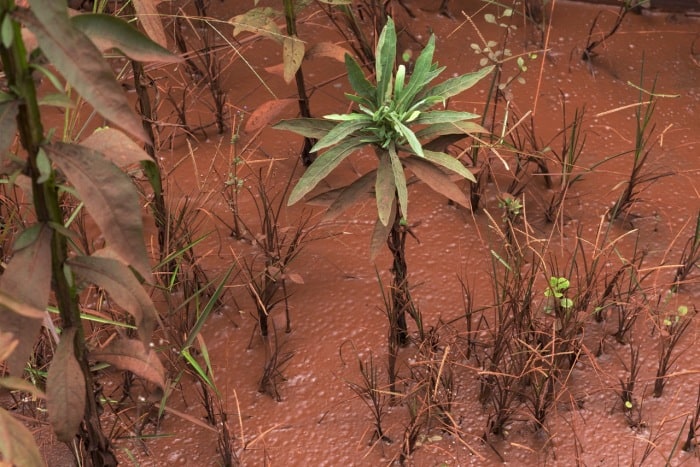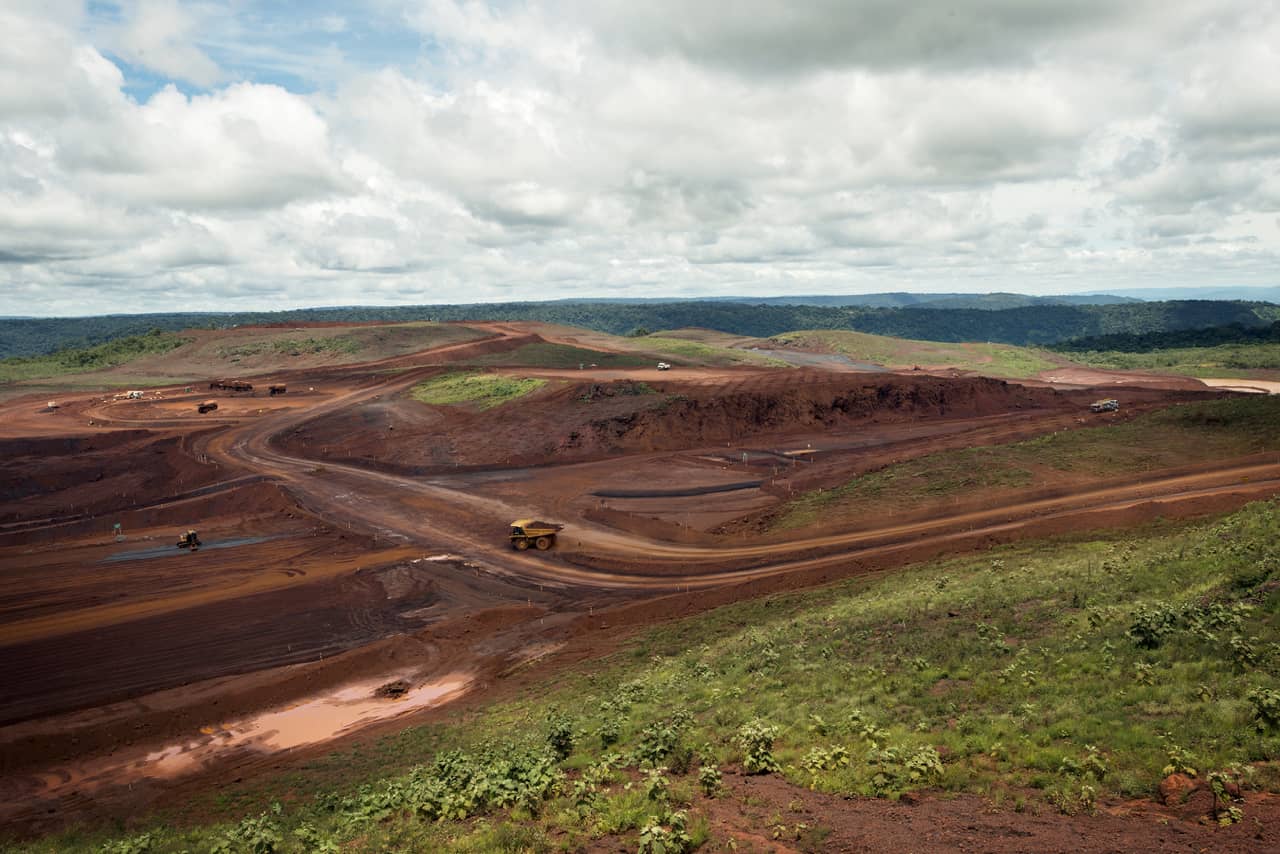SERRA SUL, Carajas, Brazil — The line of trucks and four-wheel-drive pickups threw up clouds of red dust as it snaked up the hill on the wide dirt road. From the top, Brazilian rain forest stretched out into the distance. Before it, a vast quadrangle was being carved out of the slope by an army of machines, a scar of red earth in the green hills.
S11D, as this project is unceremoniously known, is an open-cast iron ore mine being dug out of this corner of the Brazilian Amazon, in the state of Pará. Brazil’s mining giant, Vale, says the mine was designed for minimum environmental impact and maximum profitability. It is to start operating next year and by 2018 will be producing nearly 100 million tons annually of some of the purest iron ore in the world — a lifeblood for Brazil’s pallid economy.
But environmentalists argue that S11D could destroy rare savannah ecosystems found in two lakes on top of rich iron ore deposits. Dozens of caves that potentially contained evidence of ancient Amazon habitations have been lost. This grandiose $17 billion project is emblematic of a very contemporary, Brazilian dilemma: Can the country develop its rich natural resources without causing irreparable damage to its environment and history?
“I totally disagree when someone says it is not possible to develop while maintaining preservation and sustainability,” said Jamil Sebe, Vale’s director of ferrous projects for the north of Brazil, who is in charge of the mine. Sebe said he had been working a quarter of his 44 years on the project, which employed innovative mining and engineering techniques imported from Canada and Australia to reduce impact and costs.
“This is the year to put it all together,” he said.
S11D is just 30 miles south of the world’s biggest iron ore mine, also run by Vale in the same Carajas National Forest. The company’s activities here, which include copper, manganese and gold, take up 3 percent of the 1,591 square miles of this national park, as rich in nature as it is in minerals.
“Vale wants to mine everything. It will depend on the Brazilian government environmental organs to protect this area,” said Frederico Martins, an environmental analyst at the government’s Chico Mendes Conservation and Biodiversity Institute and manager of the Carajas National Forest. “There is a lot of iron ore there.”
Controversy centers on two lakes just east of current construction but on top of part of the iron ore seam. Government agencies have negotiated a 546-yard exclusion zone around them, as protection — but it may not be enough.
It took three hours to drive along treacherous dirt roads that cross the forest to reach the largest, Guitar Lake. En route, a wild boar fled across the track, the 4×4 inched around a long, black snake, and forest guide José de Costa paused under a harpy eagle’s nest the size of a bathtub as the bird’s head bobbed over the rim.
Guitar Lake’s expanse was a world apart from the dense, tangled forest around it — a separate ecosystem set in a “metallic savannah” of dark rocks and scrub. Six-inch-long, vivid green grasshoppers lounged in the sun. Caimans and turtles roamed through the lake. More than 40 plant species — among them Ipomoea marabaensis, with a lilac flower — are found only here in Carajas’s savannahs, with its environment formed by the very rocks, rich in iron ore, that endanger their survival.

In the distance, the hum of the diggers was audible. Last year local university students formed an “SOS” on rocks at the lakeside to protest the damage they argued Guitar Lake will suffer once mining and the daily explosions involved begin in earnest.
“If it survives, it will lose all its context,” said da Costa, who participated. “You won’t have all this life.”
Vale is discussing a reduction of the exclusion zone with the Brazilian government environmental agency. Martins said any reduction would “compromise the existence of the lagoon.”
Iron ore was first found in Carajas in 1967 by a Brazilian geologist prospecting manganese for U.S. Steel. In 1985, production began at Serra Norte, now the biggest iron ore mine in the world. A city of 180,000, Parauapebas, grew up nearby. Vale and its contractors employ 46,000 people in Pará.
State capitalism and protection go hand in hand here. In 1998, the Carajas National Forest reserve was created as much to isolate the mine area from squatters as protect it from the deforestation that has devastated so much of this southern corner of the Amazon.
“If it wasn’t for the mining, this could have been worse,” Martins said. Access is controlled by Vale and the Chico Mendes Institute.
The Serra Norte mine is an enormous industrial complex of pits, conveyor belts and processing units sunk deep into the forest. Everything is a dark, rusty red: the metal and the earth. On a recent morning, mine operations manager Evandro Euzébio stood at a lookout overlooking the oldest of the mine’s five pits. Hundreds of yards below him, giant trucks crawled up the dirt roads, each one carrying up to 400 of the 120 million tons of ore Vale produces there each year.
“It is the best iron ore in the world,” Euzébio said.
Ore is transported 554 miles by a single-track train line to the port of São Luís in Maranhão state. From there, cargo ships sail it to China, which imports half of what Vale produces every year. The railroad line is being duplicated to handle S11D’s production. Iron ore prices have halved to about $55 a ton over the last year, but Vale insisted the project was still viable.
“Nobody rips up money,” said the Vale North ferrous director, Paulo Horta.
S11D’s construction, with expansion of the port and train line, employs 30,000 workers. When the mine is functioning, 2,600 will work there, with 7,000 in related service industries. A new town, Canaã dos Carajas, has grown up nearby.
Instead of the trucks used at Serra Norte, five miles of conveyor belts will lift the ore out of the pits to processing plants situated outside the forest area. The plants are made of modules, fitted together like Lego pieces, a technique adopted from the oil industry that requires fewer workers on site. German, Canadian and Australian engineering companies designed much of the equipment, but most was fabricated in China. Brazil makes the raw materials but not the machines.
The S11D seam alone is over five miles long.
“It is the biggest seam, the biggest reserve that Vale has. In the future it is a platform for growth for the company,” Sebe said.
But it will also consume a part of Brazil’s past. Archaeologists say that caves in the area hold clues to Amazon habitations that were unknown until the 1980s.
Evidence from those caves suggests that nomadic peoples lived in the Amazon up to 9,000 years ago, cultivating manioc and the acai fruit.
“They managed to cultivate the forest without knocking it down,” said Marcos Magalhães, an archaeologist from the Emílio Goeldi Museum in Pará’s state capital, Belém, who has studied caves in the area. “The Amazon was the Garden of Eden.”
In one of the caves above the lake, shards of ceramics lay scattered on the floor. From photos, Magalhães said these probably dated from another occupation by nomadic indigenous groups around 500 years ago, before Brazil’s colonization by the Portuguese. The cave will be surveyed this year and is not marked for destruction.
But of 187 caves like it in Serra Sul, 40 will suffer “irreversible impact,” said Leanardo Neves, a Vale environmental and sustainability manager. Magalhães and his team surveyed and removed artifacts from five before they were knocked down.
Vale plans to compensate every cave destroyed by protecting two caves in a similar, neighboring area called Serra de Bocaina. Magalhães’s team had yet to study any of the caves there. But it did find traces of a prehistoric mine near Serra Sul, where rocks were dug for pigment. “The story of the region,” he said. “Its destiny was always mining.”
© 2015, The Washington Post







